The generation and development of flexible combination fixtures include three aspects: the design of flexible components, the technical application of flexible combination fixtures in modern machining centers, and the management of flexible combination fixtures in flexible manufacturing technology environments.
1. Design of flexible components
The machining center represented by the flexible manufacturing unit processes the assembly of multiple processes of the workpiece efficiently, and forms a process in which the jig is clamped once to complete a plurality of processes. The machine tool and the fixture and the workpiece form a diametrically opposite relationship with the traditional machining method, that is, the maximum capacity of the machined part is installed on the bottom plate of a fixture, and when the clamp is in the machining position, other fixtures with the same characteristics are being The workpiece is loaded and unloaded outside the machine, and even some fixtures mounted on the pallet are being rotated in the transmission system. Among the jig ensure precise parts to be machined can be loaded machine coordinate system, in the machining position (i.e., the fixture) after all the workpiece processing is completed, the machine and the jig fixture outer overall exchange, and the jig is repeatedly implemented machine Quick positioning connection. Due to the realization of the off-machine installation fixture and the loading and unloading of the workpiece outside the machine, the machining time of the machine tool coincides with the fixture installation and the workpiece clamping time, which greatly reduces the downtime. Based on this, the flexible combination fixture develops a series of components that are adapted and matched in the design of the component series.
The fixture is developed by directly interacting with the single machining process of the workpiece to the entire machining process of the workpiece, thereby producing a series of basic components of the flexible composite fixture represented by the multi-fixture basic plate, including the flat base plate series and the tangible class including the square. A series of basic parts of geometric shapes such as boxes, T-shaped foundations, and base angle irons. The biggest feature of these components is that the connection to the machine table is very tight and fast, and can be directly connected to the workbench or pallet of the machine tool . Even the "plate" in the pallet system is directly based on the structural elements of the flexible combination fixture component. Designed to be directly attached to the machine . Some new multi-functional positioning assemblies, clamping assemblies and positioning clamping assemblies have appeared one after another, although they have not fundamentally changed the component characteristics of the traditional combined fixtures, but replaced the cumbersome stacking, some with coordinate origin The hole-like positioning element enables the flexible combination fixture to accurately load the coordinate system of the machine tool in the positioning of a plurality of workpieces. The development of flexible combination fixture components laid the foundation for the application of flexible combination fixtures in flexible manufacturing technology environments.
2. Application of flexible combination fixture
In flexible manufacturing technology, the fixture is a key factor affecting its flexibility. In the years of practice of the Computer Integrated Manufacturing System (CIMS) test and many units of flexible manufacturing systems, it has been found that it is quite difficult to achieve unmanned or desired ideal state flexibility on the jig of the machine tool and the machined parts. . Unmanned must also have a considerable degree of technical support, or can be achieved in a certain field, but it is extremely difficult to expand to cover more areas. The most convenient way to realize the flexible state of the ideal state is to transform the traditional combination fixture, and transform the versatility advantage of the combined fixture structure into a flexible one.
The development of flexible combination fixture components laid the foundation for the application of flexible combination fixtures in flexible manufacturing technology. Flexible combination clamps have played a significant role in the flexible manufacturing of automobiles. The flexible combination fixture is more closely related to the component series and the machine tool , the component system has compression, the application of the flexible combination fixture technology on the machine tool is simplified, and the structure of the fixture is also evolved from complex to simple.
In the automotive flexible manufacturing technology environment, flexible combination clamps are used in a large number of applications, especially in the manufacture of key components such as engines, transmissions and clutches. For example, in the clamp structure of the casing and the cover of the clutch and the transmission, the bridge type clamp structure is widely used, so that the two-face machining can be conveniently realized. Since these parts are mostly aluminum alloy materials, the local stiffness of the machined parts is supported, which can be easily realized in a more intuitive field. A variety of ideal typical flexible combination fixture structures are the direct result of their technical application. Strengthening technical research and development in this area is an important part of improving the flexibility of flexible combination fixtures.
The following are specific application examples for several flexible combination fixtures. As shown in Figure 1, the automotive clutch housing parts are used in a flexible combination fixture on a vertical machining center. The fixture is only the assembly of the positioning and clamping components, the structure is simple, the opening is good, and the assembly of the fixture is only 30 minutes, and the rapidity can be seen in the flexible production. As shown in Figure 2, the automotive clutch upper housing part is a flexible combination clamp used on a horizontal machining center. It can be seen that although the jig is a frame-like structure around the part, considering the cutting force of the machining state, the frame column is composed of two bodies and is reinforced, and the positioning points and the auxiliary support points are properly distributed, which fully shows that the flexible combined jig is in its structure. Flexibility in evolution. As shown in Figure 3, the automotive clutch upper housing part is a flexible combination clamp used on a horizontal machining center. Due to the shape characteristics and positioning requirements of the parts, the flexible combination fixture can be used in almost any structural design and can withstand the processing requirements under large cutting force conditions.
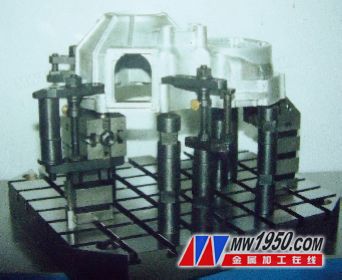
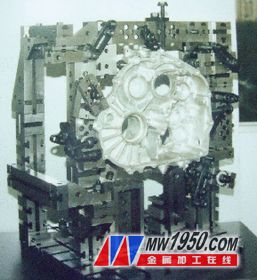
Figure 1 Figure 2
 image 3
image 3
3. Strengthen the technical management of flexible combined fixtures
Flexible combination fixture management, including component series and human assembly, and the derivation of these two factors, such as component size and management position in production preparation, component management and technical management, etc., will determine flexibility The degree to which the combined fixtures work, as well as the investment in the flexible combination fixtures (including future management inputs) and the cost performance. It can also be said that the degree of its technical exertion and management level determines the degree of flexibility.
Flexible combination fixture components, technical application, and technical management are three aspects of flexible combination fixtures. If the component is the foundation and the application of technology is the key, then the technical management is the guarantee of the former two, and in the role of the former two, it runs through the management factor. Such as the type of components, the amount of matching, the proportion of categories between components, the ratio of on-site circulation to inventory, the frequency and extent of component replacement, and the various necessary systems for component use. In the management of technology, the importance of management is more prominent.
The management mode of the traditional combination fixture has been outdated. The establishment of a large “assembly station†management method will occupy a large amount of resources and funds. In the preparation for production, there is a time lag in the rapid response of the fixture, so it must be changed. In the modern production mode, adopting a more suitable and more scientific management model is already an urgent issue.
Powered Pins Fastening System is firstly invented by our company in China. Not like as other Direct Fastening System, it only includes two parts: Tool and Powered pin. For the pins are joined to energy(Powder or solid propellant) by plastic part. Like this, we can do fastening work very rapidly. Especially for Ceiling fastening, we can do it just in floor, which is much faster than traditional way. No ladder required. No dust. Low nosie.
We can provide two kinds of Powered pins: double-base powder (DB series) and solid propellant( nitro-cotton,SP series). DB series can provide very steady and strong fastening. SP series can not only provide very steady fastening, but also can provide no-lead worksite requirements. For the system is 100% lead free in compliance with OSHA (CFR 1926.62). What's more,It is classified as non-explosive allowing for standard shipping and storage of the fasteners. The result is a system that stresses operations and environmental safety.
Our tool can be both used for two series.
Tool:
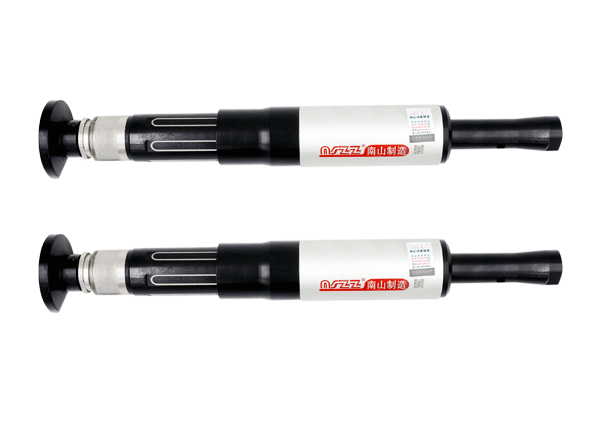
Powered Pins
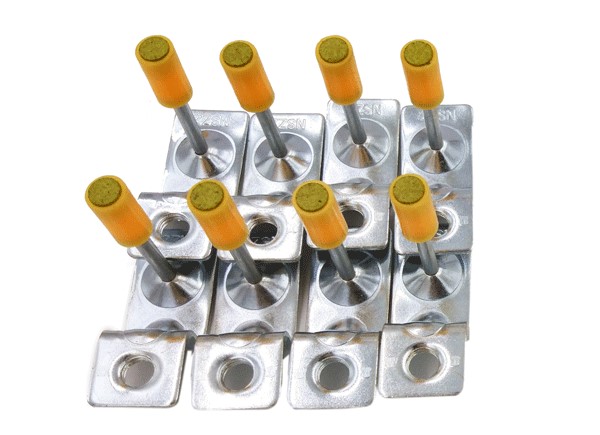
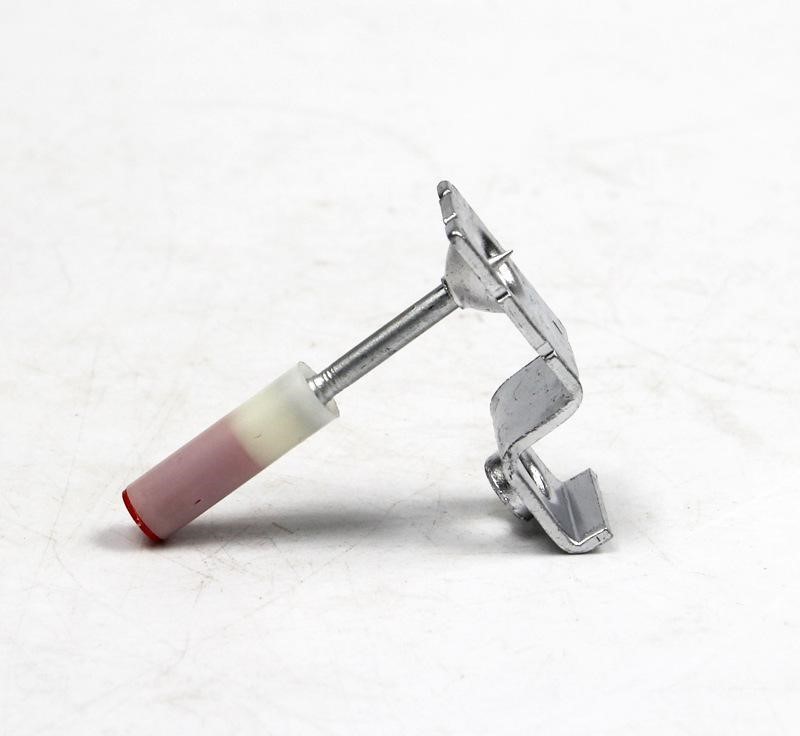
Powered Pins Fastening System
Powered Pins Fastening System,Powered Pins Fastening,Powder Actuated Fastening Tool,Overhead Fastening
Yibin Heheng Technology Co.,Ltd , http://www.chinadirectfastening.com